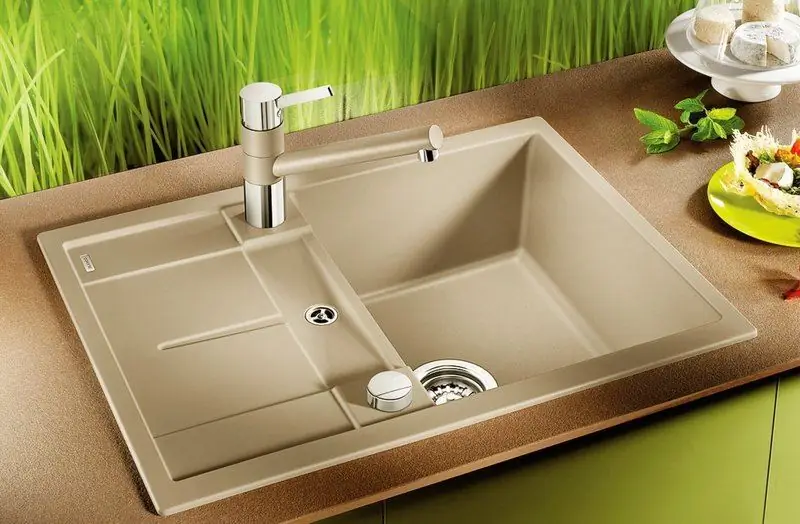
Table of contents:
- Author Bailey Albertson [email protected].
- Public 2024-01-17 22:26.
- Last modified 2025-06-01 07:32.
Flush sink for the kitchen: types, sizes, installation nuances

Currently, inset sinks are becoming increasingly popular among consumers. They have almost completely ousted from the furniture market overhead kitchen sinks, which are now found exclusively in economy class headsets.
Content
- 1 Inset sinks: advantages and disadvantages
-
2 Inset sinks: shape and dimensions
- 2.1 Photo gallery: two-bowl sinks for the kitchen
- 2.2 Photo gallery: kitchen sinks with additional fenders
- 2.3 Video: what are the sinks
-
3 What materials are used for inset kitchen sinks
3.1 Video: what kitchen sinks are made of
-
4 Nuances of installing a flush kitchen sink
4.1 Video: Installation of the flush sink
- 5 Video: choosing a kitchen sink
Flush sinks: advantages and disadvantages
If the overhead sink is simply installed on top of the kitchen cabinet, which, in fact, is what its name itself says, then a hole of the desired configuration is cut out under the cut-in sink in the countertop, where it is then inserted. It turns out that the sink is held by the sides bent along the entire perimeter.

The inset sink, unlike the overhead sink, is built into the worktop
Inset sinks have a lot of positive qualities:
- high reliability;
- compactness and ergonomics;
- practicality;
- hygiene - between the sink and the furniture modules there are no gaps and cracks in which dirt accumulates;
- long service life;
- aesthetic appearance, thanks to which such a sink looks harmonious in any kitchen;
- ease of use;
- a wide variety of sizes and shapes;
- wide color palette;
- versatility.
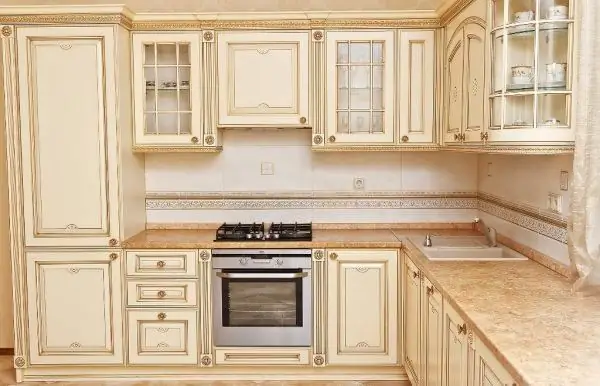
The inset sink looks harmonious in any kitchen
The disadvantages include the following characteristics:
- high price (when compared with overhead products);
- more complex installation, which not every home craftsman is able to perform with sufficient quality;
- the complexity of dismantling.
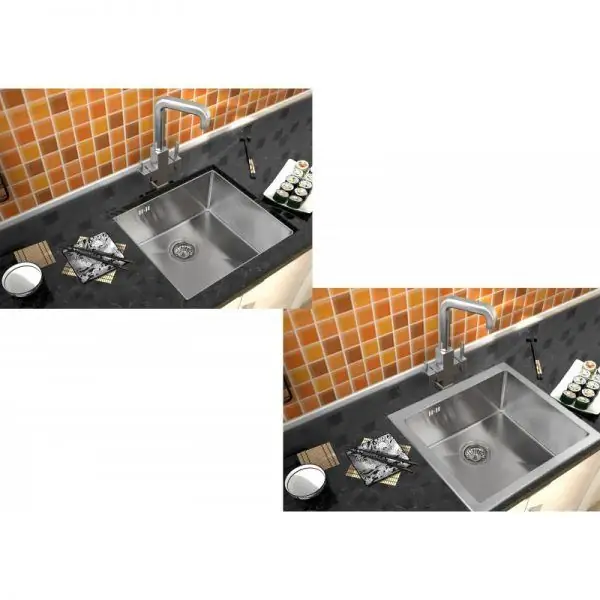
Some types of inset sinks also allow under-table installation
When we changed our sink, we had to struggle to find the right size sink. After all, there is already a hole in the countertop, and it was not part of our plans to completely change it. As a result, we bought a model with large dimensions, for which they simply increased (sawed) the existing seat with a jigsaw.
Flush sinks: shape and dimensions
In stores, you can find mortise shells of the most different configurations and shapes:
-
Square. Classic sinks with only one dishwashing bowl. Most often used in small kitchens. Sizes can vary from 40 * 40 cm (for narrow tabletops) to 50 * 50 and even a little more.

Square inset sink Square inset sinks are more often used in small kitchens
-
Round. Also single-bowl sinks, ideal for small spaces. They are considered the most capacious in terms of internal volume. Diameter from 45 to 51 cm.

Round inset sink The round sink has the largest internal volume
-
Rectangular. The most common and commonly used form. The size range is extremely wide. The smallest items in length can be about 30 cm, the largest can reach 150 cm.

Rectangular inset sink Most often, inset sinks are rectangular.
-
Corner. The sink is designed to be placed in the corner of a kitchen unit. Most often it is performed in the form of a triangle, but it can have a more complex configuration and consist of 5-6 angles.

Corner inset sink Corner inset sinks are installed in the corner of the headset
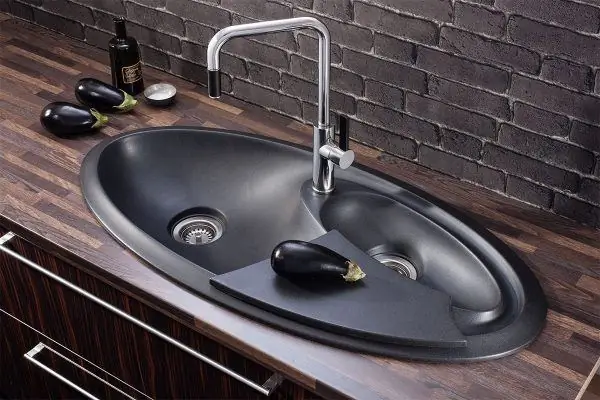
Unusual designer sinks are very expensive
Kitchen sinks differ in the number of working bowls. In addition to one main container, a second additional bowl with a smaller volume can be located on the left or right. It is intended for washing fruits, vegetables and herbs, defrosting food, etc. Many housewives prefer large sinks equipped with two full-fledged and equivalent containers, in one of which you can soak dirty dishes with dried food residues.
Photo gallery: two-bowl sinks for the kitchen
-

Large two-bowl sink - The sink can have one large bowl and the other slightly smaller
-

Unusual two-bowl sink - There are two-bowl sinks of an unusual shape on sale
-

Sink with large and small bowl - If the sink is small, then a small bowl can be used to wash cutlery
-

Oval double bowl sink - Oval two-bowl sinks look very interesting
-

Corner sink with large and small bowl - A corner sink often has a large main bowl and a small one for washing greenery.
-

Corner sink with two large bowls - Large corner sink with two full bowls is suitable for a large family
-

Double bowl sink by the window - Bowls can be the same depth but differ in width
-

Double bowl inset sink with identical bowls - The inset sink can have two absolutely equal bowls
-

Three-bowl sink - there are models of inset sinks with two identical bowls and one small
-

Corner sink with three bowls - Corner sinks can have up to three bowls of different sizes and shapes
-

The original two-bowl sink - A two-bowl sink can have a large round bowl and an additional smaller one
An important parameter of flush-mounted sinks is their depth. The best bowl is 16-20 cm deep. In shallower shells, falling water is heavily splashed, Too deep are not too comfortable, as you have to bend over.
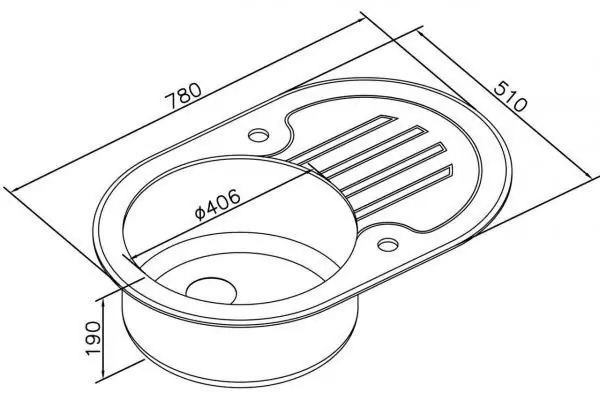
The depth of the bowl is considered optimal from 16 to 20 cm.
In everyday use, fenders-dryers are very practical, they are additional surfaces on the sides of the main bowl. You can lay out the washed dishes on them or use them as an additional work surface. Such a wing may have the smallest size (no more than 10-15 cm) and rather large (about 50-60 cm).
Photo gallery: kitchen sinks with additional fenders
-

Large sink with drainer - The sink can have a very large bowl and drainer
-

Oval sink with drainer - The oval sink has a round bowl and a fairly large drainer
-

Small oval sink - A small oval sink with a small drainer is suitable for very small kitchens
-

Large sink with two wings - For large kitchens, sinks with two large wings are appropriate.
-

Sink with wing on the right - The fender on the sink can be decorated in an unusual way
-

Oval sink under the window - Oval sinks under the window look interesting
-

Inset sink with drainer - The wing can flow smoothly into the bowl
-

Corner sink with two wings - The simplest corner sink always has a large bowl and two wings.
Any modern inset sink is equipped with an overflow - a special hole that allows excess water to be dumped into the sewer. An emergency situation can occur as a result of clogging of the drain fittings with pieces of solid waste or fat deposits.
There are two options for placing the overflow hole:
-
on the side of the bowl;

Sink with overflow in the bowl The overflow can be placed on the side of the bowl
-
on the wing.

Sink with overflow on the wing Washing a sink with an overflow on the fender is a little more difficult
Washers differ in the water outlet system. In the simplest and cheapest version, the drain hole is simply closed with a plastic stopper. Much more convenient, but also slightly more expensive, is the option with a grate for retaining food waste, which can be lowered to block the outlet and collect water in the bowl.
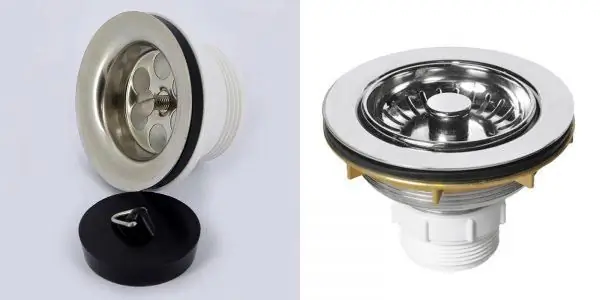
Kitchen sinks are different
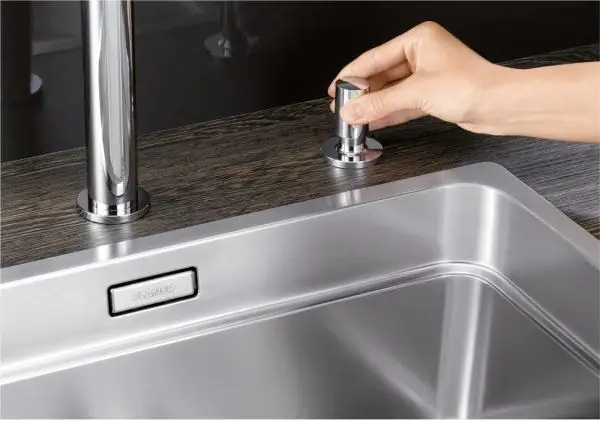
The automatic valve allows you to drain water from the sink without getting your hands wet
Mortise sinks are most often already equipped with a ready-made hole for a mixer, which is made in the middle of the far side of the sink. But options are possible with the placement of the kitchen tap on the right or left. Some models (especially made of artificial stone) are versatile and reversible, so the hole for the mixer is drilled only when it is installed.
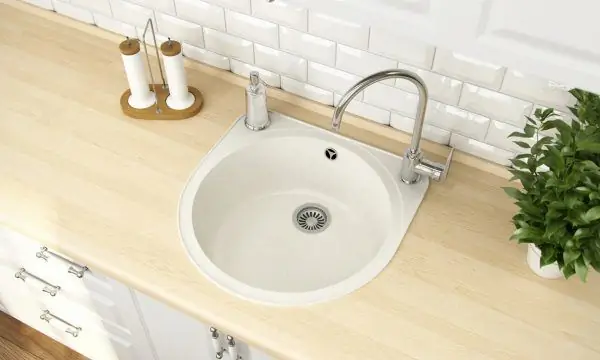
The mixer can be located on the side
Inset sinks can be equipped with a large number of useful accessories that make kitchen work easier and more convenient:
- dish dryers;
- colander;
- baskets;
- cutting boards;
- detergent dispensers, etc.
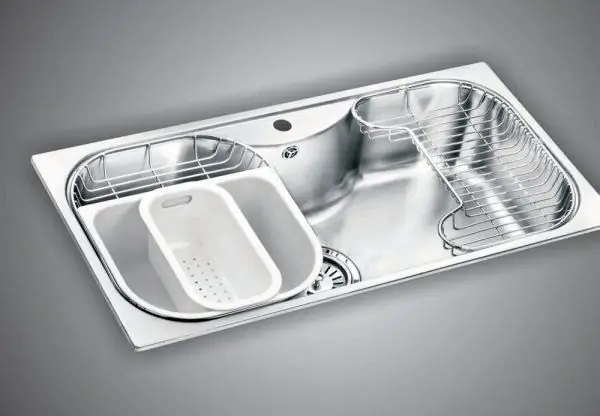
Inset sinks are equipped with various accessories
Video: what are the sinks
What materials are cut-in kitchen sinks made of?
Mortise sinks are made of the following materials:
-
Stainless steel. Due to the optimal ratio of price and quality, it is the most popular and affordable material that is resistant to shock loads and high temperatures, immune to aggressive chemical environments, practical, durable, easy to maintain and hygienic. Good food steel used for the manufacture of kitchen sinks, dishes and other utensils must contain at least 18% chromium and from 8 to 10% nickel (as evidenced by the corresponding marking 18/10). The sheet steel used in production has different thicknesses. Cheap models are thin (0.5-0.6 mm), more expensive products are 0.8 to 1.2 mm thick. The surface is of various types:
- glossy (polished);
- matte;
-
decorated (simple pattern applied by mechanical knurling).

Decorated steel for kitchen sinks A stainless steel sink can have a decorated surface
-
Composite materials. Strong compounds (silgranite, fragranite, etc.) made from quartz sand or granite chips (up to 80%) and acrylic resins as a binder. Sinks made of artificial stone are not afraid of mechanical and high-temperature (up to 280 ° C) influences, are quiet (absorb the sound of falling water), are resistant to acids and dyes, and have a large number of colors.

Composite sink Composite sinks come in a variety of colors
-
Ceramics. In the production of ceramic kitchen sinks, special types of refractory clay are used, as well as various mineral additives, plasticizers and additives that are sintered during high-temperature firing. These sinks are scratch and abrasion resistant, heat resistant, durable and very easy to clean. But they have considerable weight and relative fragility during point impacts (chips and microcracks can form).

Ceramic sink The ceramic sink has a sophisticated appearance but is quite expensive
At first, due to lack of finances, we were forced to purchase the simplest and cheapest stainless steel sink for the kitchen. In care, it was extremely impractical, since stains remained even from clean water. In addition, water poured into it with a crash and spray. A few months later, a ceramic granite sink from the German brand Blanco was purchased. It is easy to clean, dirt on it is almost invisible, and the appearance is much better.
Video: what kitchen sinks are made of
The nuances of installing a flush kitchen sink
The sequence of actions is as follows:
-
Markup. Many sinks come with a special template. If it is not there, then the sink is turned over, placed in the right place on the countertop and traced around the entire perimeter with a pencil or marker. Then the sink is removed and another line is drawn inside the contour, stepping back about 15 mm.

Markup First you need to do the markup
-
Several technological holes (usually at the corners) with a diameter of 10-12 mm are drilled inside the contour.

Drilling holes Several holes are drilled inside the contour
-
With an electric jigsaw, cut a hole in the tabletop along the entire contour.

Jigsaw Using a jigsaw, cut a hole around the entire perimeter
- The edges of the cuts are cleaned with a file or sandpaper and cleaned of sawdust and dust.
-
The saw cut is carefully treated with silicone sealant to protect it from moisture.

Worktop cut-out The edges of the cutout must be treated with varnish or silicone sealant
-
A siphon and a faucet are installed on the sink, and a foam rubber seal is glued to the inner rim (comes with the sinks).

Sink assembly A siphon and a mixer are installed on the sink
-
The sink is inserted into the hole made and pulled tightly from below using fasteners.

Sink installation The assembled shell is placed in the hole made
- Squeezed out excess silicone is immediately wiped off with a sponge or cloth.
- Connected to water supply and sewerage.
- The kitchen sink can only be used after the sealant has completely dried.
Video: installation of a flush sink
Video: choosing a kitchen sink
The choice of a kitchen sink should be approached thoroughly and seriously, because the convenience of using the entire kitchen set largely depends on this. The modern market offers a huge range of inset built-in sinks that can satisfy any demanding taste.
Recommended:
How To Clear A Blockage In The Kitchen At Home, What To Do If The Sink Is Clogged, How To Break A Drain In A Pipe
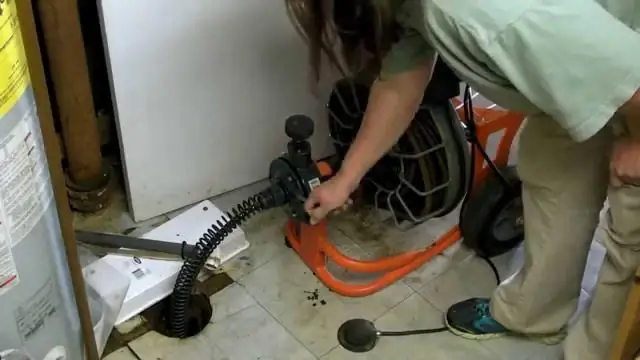
How to remove a blockage from your kitchen sink using proven methods and tools
Corner Sink For The Kitchen: Choice Of Shape And Size, Location Options, Photo

What is a corner kitchen sink. The advantages and disadvantages of such sinks, shapes and sizes. Manufacturing material, installation methods. Tips for choosing
Overhead Sink For The Kitchen: Design Features, Recommendations For Choosing
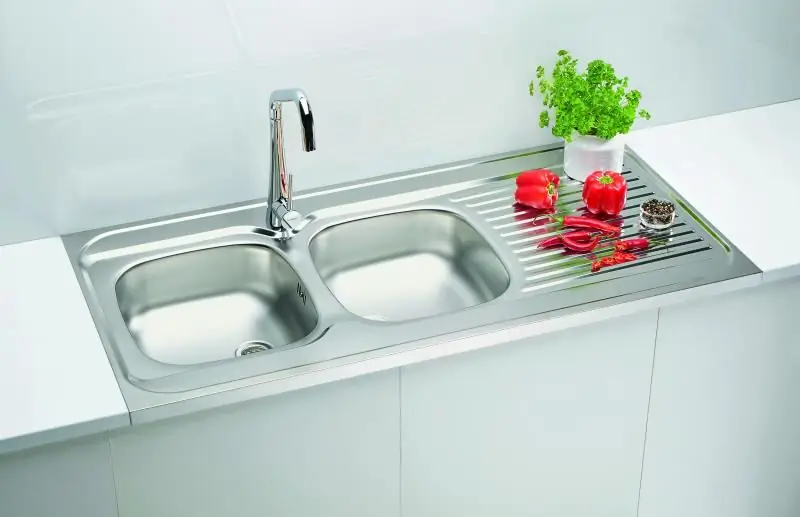
What is an overhead kitchen sink, its pros and cons, how it differs from a mortise one. The choice of shape and size, material, manufacturer. Installation features. Care
Double Sink For The Kitchen: Purpose, Features And Dimensions, Installation Nuances
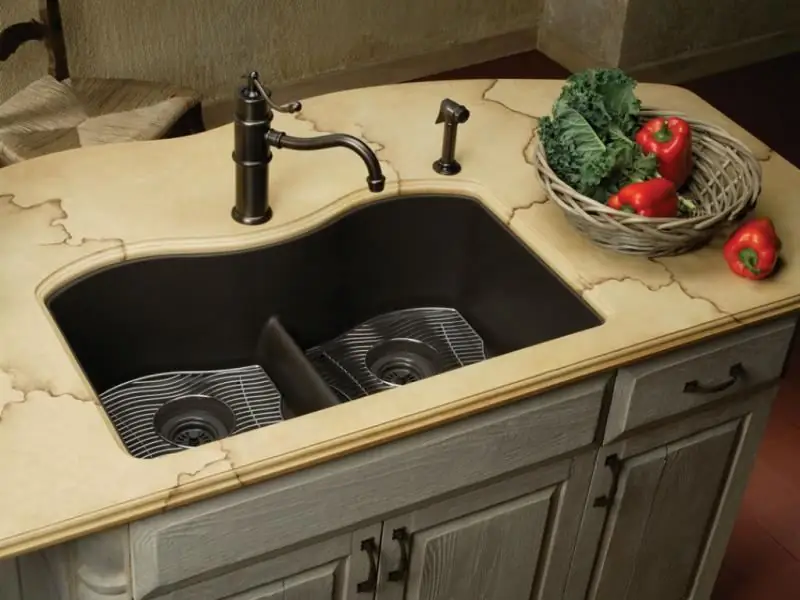
What are double kitchen sinks and what you should look for when buying. How to install a sink yourself
Dropper For Metal Tiles, Including Its Types And Sizes, As Well As Device And Installation
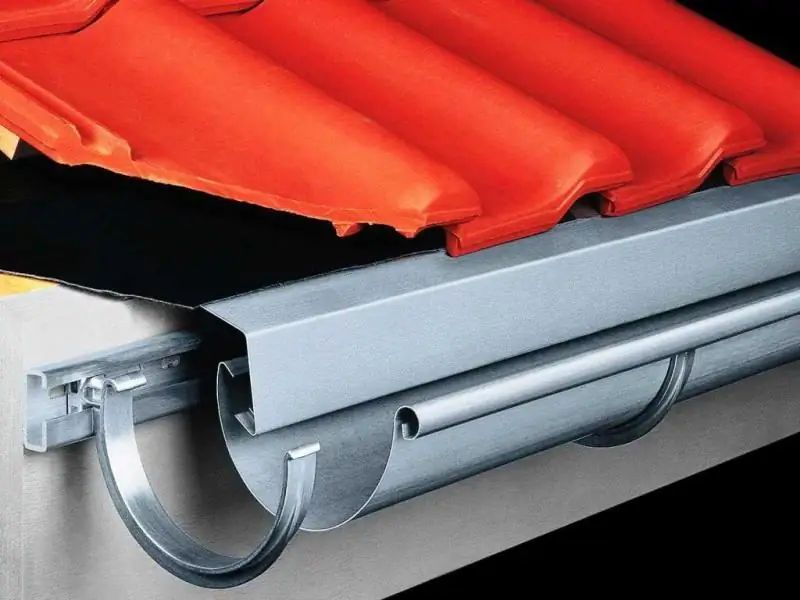
What is a drip. Purpose and types of eaves aprons on a metal roof. How to install a drip on the roof yourself
